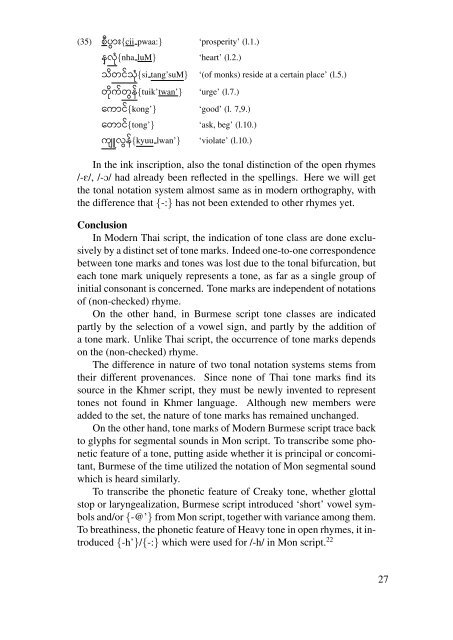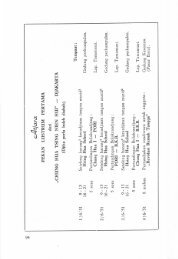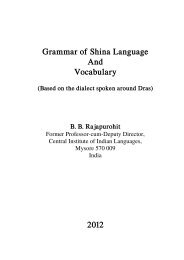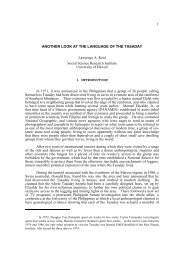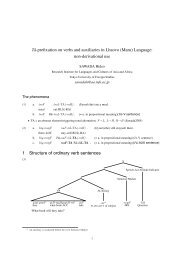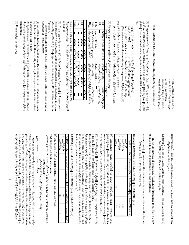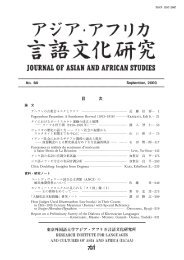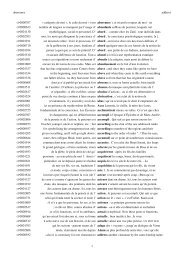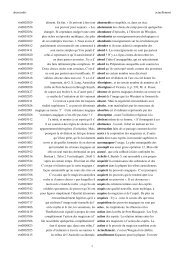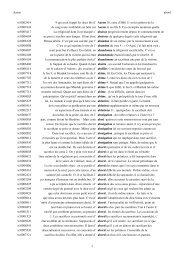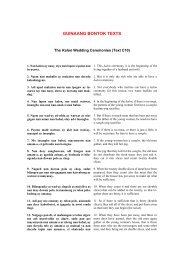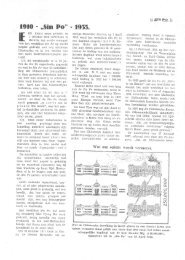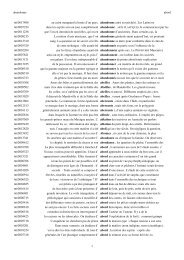Tonal Notation of Indic scripts in Mainland Southeast Asia
Tonal Notation of Indic scripts in Mainland Southeast Asia
Tonal Notation of Indic scripts in Mainland Southeast Asia
You also want an ePaper? Increase the reach of your titles
YUMPU automatically turns print PDFs into web optimized ePapers that Google loves.
(35) c¯pWA:{cii pwaa:} ‘prosperity’ (l.1.)<br />
nH`luM{nha<br />
luM} ‘heart’ (l.2.)<br />
s˘t`N¸suM{si<br />
tang’suM} ‘(<strong>of</strong> monks) reside at a certa<strong>in</strong> place’ (l.5.)<br />
tuik¸tW`n’{tuik’twan’}<br />
‘urge’ (l.7.)<br />
ekAN¸{kong’} ‘good’ (l. 7,9.)<br />
etAN¸{tong’} ‘ask, beg’ (l.10.)<br />
kYâlW`n’{kyuu<br />
lwan’} ‘violate’ (l.10.)<br />
In the <strong>in</strong>k <strong>in</strong>scription, also the tonal dist<strong>in</strong>ction <strong>of</strong> the open rhymes<br />
/-E/, /-O/ had already been reflected <strong>in</strong> the spell<strong>in</strong>gs. Here we will get<br />
the tonal notation system almost same as <strong>in</strong> modern orthography, with<br />
the difference that {-:} has not been extended to other rhymes yet.<br />
Conclusion<br />
In Modern Thai script, the <strong>in</strong>dication <strong>of</strong> tone class are done exclusively<br />
by a dist<strong>in</strong>ct set <strong>of</strong> tone marks. Indeed one-to-one correspondence<br />
between tone marks and tones was lost due to the tonal bifurcation, but<br />
each tone mark uniquely represents a tone, as far as a s<strong>in</strong>gle group <strong>of</strong><br />
<strong>in</strong>itial consonant is concerned. Tone marks are <strong>in</strong>dependent <strong>of</strong> notations<br />
<strong>of</strong> (non-checked) rhyme.<br />
On the other hand, <strong>in</strong> Burmese script tone classes are <strong>in</strong>dicated<br />
partly by the selection <strong>of</strong> a vowel sign, and partly by the addition <strong>of</strong><br />
a tone mark. Unlike Thai script, the occurrence <strong>of</strong> tone marks depends<br />
on the (non-checked) rhyme.<br />
The difference <strong>in</strong> nature <strong>of</strong> two tonal notation systems stems from<br />
their different provenances. S<strong>in</strong>ce none <strong>of</strong> Thai tone marks f<strong>in</strong>d its<br />
source <strong>in</strong> the Khmer script, they must be newly <strong>in</strong>vented to represent<br />
tones not found <strong>in</strong> Khmer language. Although new members were<br />
added to the set, the nature <strong>of</strong> tone marks has rema<strong>in</strong>ed unchanged.<br />
On the other hand, tone marks <strong>of</strong> Modern Burmese script trace back<br />
to glyphs for segmental sounds <strong>in</strong> Mon script. To transcribe some phonetic<br />
feature <strong>of</strong> a tone, putt<strong>in</strong>g aside whether it is pr<strong>in</strong>cipal or concomitant,<br />
Burmese <strong>of</strong> the time utilized the notation <strong>of</strong> Mon segmental sound<br />
which is heard similarly.<br />
To transcribe the phonetic feature <strong>of</strong> Creaky tone, whether glottal<br />
stop or laryngealization, Burmese script <strong>in</strong>troduced ‘short’ vowel symbols<br />
and/or {-@’} from Mon script, together with variance among them.<br />
To breath<strong>in</strong>ess, the phonetic feature <strong>of</strong> Heavy tone <strong>in</strong> open rhymes, it <strong>in</strong>troduced<br />
{-h’}/{-:} which were used for /-h/ <strong>in</strong> Mon script. 22<br />
27


